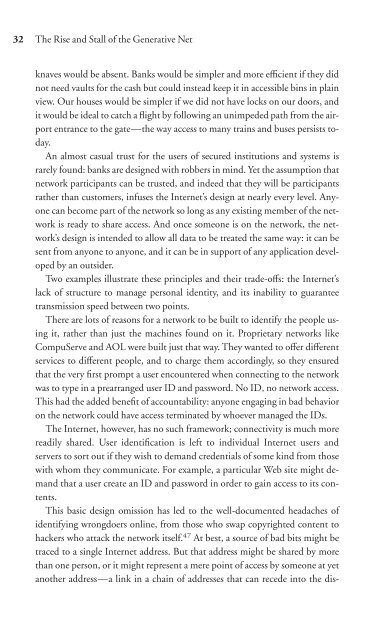Download - Future of the Internet â And how to stop it.
Download - Future of the Internet â And how to stop it.
Download - Future of the Internet â And how to stop it.
You also want an ePaper? Increase the reach of your titles
YUMPU automatically turns print PDFs into web optimized ePapers that Google loves.
32<br />
The Rise and Stall <strong>of</strong> <strong>the</strong> Generative Net<br />
knaves would be absent. Banks would be simpler and more efficient if <strong>the</strong>y did<br />
not need vaults for <strong>the</strong> cash but could instead keep <strong>it</strong> in accessible bins in plain<br />
view. Our houses would be simpler if we did not have locks on our doors, and<br />
<strong>it</strong> would be ideal <strong>to</strong> catch a flight by following an unimpeded path from <strong>the</strong> airport<br />
entrance <strong>to</strong> <strong>the</strong> gate—<strong>the</strong> way access <strong>to</strong> many trains and buses persists <strong>to</strong>day.<br />
An almost casual trust for <strong>the</strong> users <strong>of</strong> secured inst<strong>it</strong>utions and systems is<br />
rarely found: banks are designed w<strong>it</strong>h robbers in mind. Yet <strong>the</strong> assumption that<br />
network participants can be trusted, and indeed that <strong>the</strong>y will be participants<br />
ra<strong>the</strong>r than cus<strong>to</strong>mers, infuses <strong>the</strong> <strong>Internet</strong>’s design at nearly every level. Anyone<br />
can become part <strong>of</strong> <strong>the</strong> network so long as any existing member <strong>of</strong> <strong>the</strong> network<br />
is ready <strong>to</strong> share access. <strong>And</strong> once someone is on <strong>the</strong> network, <strong>the</strong> network’s<br />
design is intended <strong>to</strong> allow all data <strong>to</strong> be treated <strong>the</strong> same way: <strong>it</strong> can be<br />
sent from anyone <strong>to</strong> anyone, and <strong>it</strong> can be in support <strong>of</strong> any application developed<br />
by an outsider.<br />
Two examples illustrate <strong>the</strong>se principles and <strong>the</strong>ir trade-<strong>of</strong>fs: <strong>the</strong> <strong>Internet</strong>’s<br />
lack <strong>of</strong> structure <strong>to</strong> manage personal ident<strong>it</strong>y, and <strong>it</strong>s inabil<strong>it</strong>y <strong>to</strong> guarantee<br />
transmission speed between two points.<br />
There are lots <strong>of</strong> reasons for a network <strong>to</strong> be built <strong>to</strong> identify <strong>the</strong> people using<br />
<strong>it</strong>, ra<strong>the</strong>r than just <strong>the</strong> machines found on <strong>it</strong>. Proprietary networks like<br />
CompuServe and AOL were built just that way. They wanted <strong>to</strong> <strong>of</strong>fer different<br />
services <strong>to</strong> different people, and <strong>to</strong> charge <strong>the</strong>m accordingly, so <strong>the</strong>y ensured<br />
that <strong>the</strong> very first prompt a user encountered when connecting <strong>to</strong> <strong>the</strong> network<br />
was <strong>to</strong> type in a prearranged user ID and password. No ID, no network access.<br />
This had <strong>the</strong> added benef<strong>it</strong> <strong>of</strong> accountabil<strong>it</strong>y: anyone engaging in bad behavior<br />
on <strong>the</strong> network could have access terminated by whoever managed <strong>the</strong> IDs.<br />
The <strong>Internet</strong>, <strong>how</strong>ever, has no such framework; connectiv<strong>it</strong>y is much more<br />
readily shared. User identification is left <strong>to</strong> individual <strong>Internet</strong> users and<br />
servers <strong>to</strong> sort out if <strong>the</strong>y wish <strong>to</strong> demand credentials <strong>of</strong> some kind from those<br />
w<strong>it</strong>h whom <strong>the</strong>y communicate. For example, a particular Web s<strong>it</strong>e might demand<br />
that a user create an ID and password in order <strong>to</strong> gain access <strong>to</strong> <strong>it</strong>s contents.<br />
This basic design omission has led <strong>to</strong> <strong>the</strong> well-documented headaches <strong>of</strong><br />
identifying wrongdoers online, from those who swap copyrighted content <strong>to</strong><br />
hackers who attack <strong>the</strong> network <strong>it</strong>self. 47 At best, a source <strong>of</strong> bad b<strong>it</strong>s might be<br />
traced <strong>to</strong> a single <strong>Internet</strong> address. But that address might be shared by more<br />
than one person, or <strong>it</strong> might represent a mere point <strong>of</strong> access by someone at yet<br />
ano<strong>the</strong>r address—a link in a chain <strong>of</strong> addresses that can recede in<strong>to</strong> <strong>the</strong> dis-


